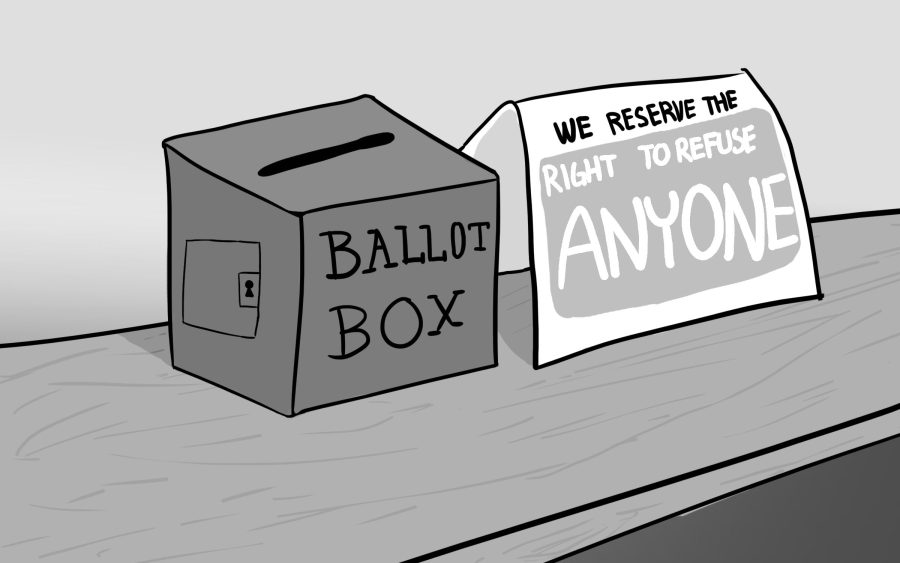
Illustration by David G Juarez
Expressing dissatisfaction with both major-party candidates running in November’s election, some voters are looking to third-party candidates. In response, some have criticized the so-called protest vote.
In Non-Swing States, Safely Promote Third Parties’ Prominence with a Vote
In the upcoming election, a significant amount of Americans have reported plans to vote for their third-party conscience over the lesser of two mainstream evils. In response, many shame these voters as selfish idealists whose wasted protest vote actually makes them complicit in electing the least desirable mainstream candidate. This kind of vote-shaming relies on misconceptions about our responsibilities as voters, especially in non-swing states like California where the exodus of voters to third parties happens to both major sides, and will not likely change statewide leanings.
Many forget that an electoral college ultimately elects the president, not a total count of individual votes, and this process funnels everyone’s votes first through a statewide level, and then nationwide. Many states, including California, have a solid leaning, and only a few swing states remain on the fence as to whom they will elect.
The goal of voting, at least in non-swing states, becomes a matter of securing more resources and recognition for third parties to shift the national discourse. According to the Federal Election Commission, if a party receives over 5 percent of the vote, it qualifies for a public grant of $20 million, or grants matching every private donation that meets certain conditions.
If the Green or Libertarian parties qualify, this could give them the campaign infrastructure they need to participate in primetime debates and secure ballot access in enough areas next cycle to build movements that better represent American opinions. Voting should not feel like a twisted prisoner’s dilemma, but rather an earnest bid for accurate representation, and — at least in non-swing states — there seems like no downside in helping secure funding for marginalized parties that might just challenge our dismal status quo.
– THOMAS FINN, Senior Staff Writer
To Lay the Groundwork for A Third-Party President, Start Locally
It is true that third-party politicians ought to gain a stronger voice in American politics. Independent parties have not held more than two seats in the Senate since 1941, according to the U.S. Senate. However, the growth of the third party will come from winning elections at lower levels and building support locally, not from what the Huffington Post describes as “random performance in presidential elections.” We must, in the words of Sen. Elizabeth Warren, “channel that frustration with the system into making government work.”
In the close presidential race ahead of us, channeling such frustration is more crucial than ever. Advocating for a third-party candidate at the presidential scale yields a marginal impact for the third-party agenda and — given how support for Libertarian candidate Gary Johnson has not far surpassed 10 percent — is certainly less significant than preventing a Trump presidency. Sixteen years ago, George W. Bush won by 537 votes. Donald Trump could be next.
The Libertarian platform calls to abolish environmental regulation, public schooling and income tax, a mass privatization conflicting with the progressivism millennials supported in Sen. Bernie Sanders’ campaign. Yet, according to a Quinnipiac poll, 29 percent of Americans between 18 and 34 would vote Johnson if the election occurred today. By voting a third-party platform in protest, we detract from the lead Clinton currently has. Clinton’s policies may be generally center-left, but with support from Sanders and Warren, she has developed progressive stances, such as making college free for 80 percent of students. As stated by President Barack Obama, “all the work we’ve done over the last eight years is on the ballot.” A vote for a third-party candidate may very well obliterate much of the progress made by the Obama administration.
– AARTHI VENKAT, Senior Staff Writer
To Eliminate “Lesser of Two Evils” Dilemma, Change Voting Process
Rather than argue over the significance of third-party voting (or lack thereof), voters discontent with our current two-party system should look toward overhauling our elective process in general by implementing immediate runoff voting, which helps multiparty systems.
The largest flaw with our current voting system, oftentimes called “First Past the Post Voting,” is the so-called spoiler effect which decreases the prevalence of third-party candidates by encouraging voters to vote against the candidate who they most dislike. A third party, therefore, will ultimately hurt its own interests by drawing away votes from the most similar candidate and allowing the opposition to win. Voters recognize this and often only vote for one member of the two-party system, not a third party.
A far better voting system called alternative voting, or instant runoff voting, works by having citizens rank their candidates from least to most desirable. Once the ballots are counted and, assuming no single candidate has a majority (greater than 50 percent) of the first-place votes, then the candidate with the fewest number of first-place bids is eliminated and the votes from those ballots are then transferred to whichever candidate was listed as the ballot’s second choice. This cycle repeats until one candidate gets a majority of the cast ballots.
Because voters could accurately vote for their most desired candidate without fear of the opposition winning, third-party candidates would be far more viable under this system. It is therefore essential that concerned citizens lobby their elected officials to move toward a more balanced electoral system that allows for political newcomers to enter without fear of hurting their own interests.
– NATE WALKER, Editorial Assistant